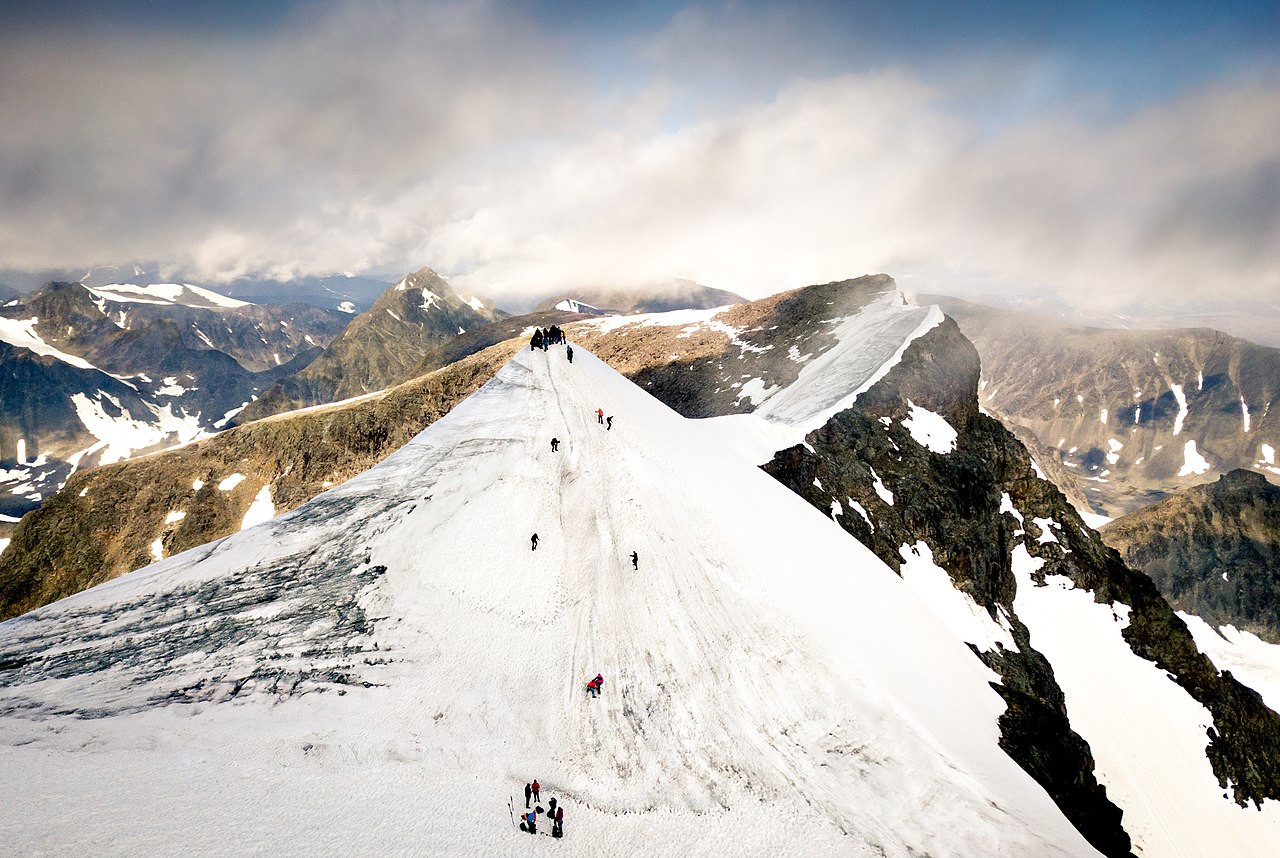On 14 August 2021, researchers measured the southern peak of Sweden’s highest mountain, Kebnekaise, at 2,094.6 meters above sea level. This is the lowest height since measurements began in the 1940s, and almost two meters lower than the same time last year.
From the mid-1940s on, there has been an unbroken series of measurements of Kebnekaise’s southern peak, carried out by researchers at Stockholm University’s research station in Tarfala. The measurements show that the south peak’s snow drift varied in both height and shape during the 20th century. The height varies two to three meters between summer and winter. Normally, the peak is at its highest in May and lowest in September.
Lowest measured height since the 1940s
On 14 August this year, researchers at Tarfala research station measured Kebnekaise’s southern peak to 2 094,6 meters above sea level (with a margin of error of ± 0.2 meters). It is the lowest height measured since the 1940s. The measurement made on 7 August 2020 showed that the south peak’s height was 2 096,5 meters above sea level (and then melted down another half meter on to mid-September). In the past year, the meltdown is therefore closer to two meters.
Since 2000, the height of the highest peak has decreased drastically. At the same time, the drift has increased in thickness in some places. The height of the peak is strongly linked to Storglaciärens mass balance, which is measured annually.
“The height variation is therefore a good symbol of the glaciers’ response to a warming climate in Sweden. When hikers climb the top today, they pass a flat part – a ‘pre-peak’ – which did not exist in the early 2000s. Since 2020, the peak is 2.2 meters lower, but the ‘pre-peak’ has grown by up to 1.2 meters,” says Per Holmlund, Professor of Glaciology at Stockholm University and Deputy Director of Tarfala Research Station.
Rising air temperature and changing wind conditions
On average, the entire drift has decreased in thickness by 0.5 meters since 2020. This corresponds to approximately 26,000 tonnes of water or 96 percent of Kaknästornet’s volume. The decrease in the peak and the changed appearance of the drift can mainly be explained by rising air temperature, but is also a result of changing wind conditions affecting where the snow accumulates in winter.
Last week, the UN’s Intergovernmental Panel on Climate Change presented the first part of the Sixth Assessment Report, Climate Change 2021: The Physical Science Basis. The Summary for Policymakers emphasizes that the melting of glaciers around the world has been “unparalleled” for the past 2,000 years, and predicts that glaciers will continue to decline in size for centuries to come.
Kebnekaise’s northern peak is now higher than the southern peak
In August 2018, researchers at Tarfala Research Station were – for the first time – able to establish that the southern peak of Kebnekaise was lower than the northern peak on the same mountain. Sweden officially had a new highest point: Kebnekaise’s northern peak with a height of 2 096,8 meters above sea level. The highest point of the northern peak consists of mountains and is thus stable. This development means that the northern peak, in the long run, will become Sweden’s highest point all year round.
This article was adapted from a media release provided by Stockholm University. A Swedish version of this article can be found on the Stockholm University website.
More information
Follow Tarfala Research Station on social media:
Twitter: @NKirchnerSthlm (Nina Kirchner, Director at Tarfala Research Station & Co-Director at Bolin Centre for Climate Research)
Facebook: TarfalaResearchStation
Contacts:
Per Holmlund, Professor of Glaciology at Stockholm University and Deputy Director of Tarfala Research Station.
Telephone: +46 8-164811
E-mail: per.holmlund@natgeo.su.se
Read more:
Holmlund, P. and Erik S. Holmlund, E. S. ‘Recent climate-induced shape changes of the ice summit of Kebnekaise, Northern Sweden.’ Geografiska Annaler: Series A, Physical Geography: https://doi.org/10.1080/04353676.2018.1542130
Cover image: South and north top of Kebnekaise by Carl Månsson, CC BY 2.0, via Wikimedia Commons.


